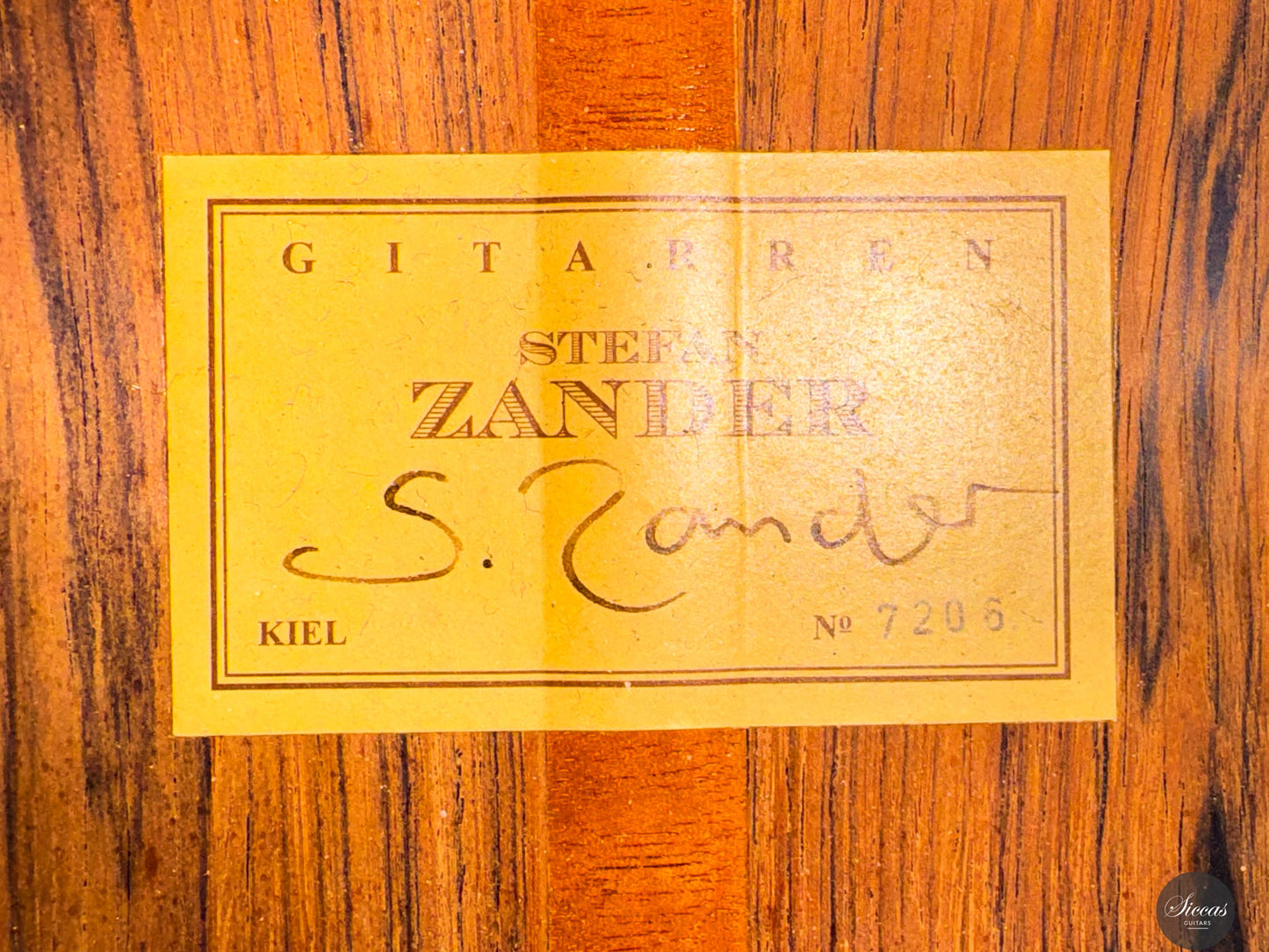Stefan Zander - 2006 - No.7206
Stefan Zander - 2006 - No.7206
Details
Details
Overview
Overview
Shipping important note
Shipping important note
Delivery times are typically reliable and most instruments arrive within the estimated timeframe.
Should any unexpected delay occur, our team will keep you informed and provide support at every step. For all shipping details and exceptions, please see our Shipping Policy.
Details about GPSR
Details about GPSR
























Video overview


More details about the guitar
About the luthier
Stefan Zander has been building guitars for over three decades, earning recognition for instruments that combine precision, balance, and tonal depth. His work is rooted in the tradition of the Spanish guitar but informed by his own design concepts. Zander places emphasis on energy-efficient sound transmission, careful voicing of tonewoods, and exact craftsmanship down to the smallest details. Each instrument is hand-tuned to achieve a broad palette of colors, wide dynamic range, and excellent playability. By blending traditional methods with a deep knowledge of acoustics and materials, Zander has created instruments that are highly valued by discerning performers.About the guitar
This guitar, built in 2006, features a spruce top and Brazilian rosewood back and sides (CITES certified). The construction follows a traditional concept, but its bracing is particularly interesting: five almost parallel braces combined with a split transversal bar. This internal structure contributes to its solid and responsive voice, ensuring both projection and balance. At 1495 grams, it is moderately lightweight and easy to handle. The tonal response of this instrument is direct and intuitive, offering an effortless connection between the player and the sound. The guitar produces a full and clear voice with excellent separation, natural sustain, and refined dynamic control. Its Brazilian rosewood body enhances tonal richness and depth, while the spruce soundboard provides clarity and definition. The result is an instrument that feels secure and reliable under the hands while offering expressive versatility across the repertoire.Condition
The guitar is in excellent condition. A small crack on the back has been carefully glued and is considered stable. Otherwise, the instrument shows minimal wear and remains structurally sound. The French polish finish is well preserved, and the Sloane tuners operate precisely. The guitar is fully performance-ready.Regular care extends the life of the instrument
Even with careful use, a classical guitar may gradually change in appearance or respond to unstable storage conditions. Have a close look at your guitar regularly and be attentif to changes. If your instrument is suffering from its environement, it will let you know.
Protect Your Guitar: Handle with Care
Be mindful when touching your instrument with greasy or unwashed hands: any skin contact is a small attack on the varnish. Of course, a guitar is made to be played, but taking a few precautions helps preserve its beauty: wash your hands before playing, wear long sleeves, and avoid unnecessary direct skin contact with the body of the instrument.
Pro tip: Avoid playing with a button-up shirt, heavy jewelry, or a belt, as these can scratch the guitar. Also, make sure your guitar case is free of any objects that could damage the instrument during storage.
String care
A good habit to adopt is wiping down your strings briefly after each playing session. This small action significantly extends their lifespan and helps maintain a consistent, comfortable feel under your fingers.
Most importantly, clean strings are essential for keeping your instrument in tune. Corrosion, sweat, and dust can affect the uniformity of the strings and interfere with accurate tuning across the entire fingerboard.
Pro tip: If you're having trouble getting your guitar in tune, it might be time to change the strings. A useful test is to compare the pitch of the 12th fret harmonic with the fretted note at the 12th fret; if there's an unusually large gap between them, your strings may have lost their integrity and should be replaced.
Keep Your Shellac Finish Shining!
Got a guitar with a shellac (French polish) finish? Here's a simple trick: Take a clean microfiber cloth and gently breathe on the surface to create a light mist. Then, softly rub to remove fingerprints, sweat, and grease. That’s usually all it takes to keep it looking great, no products needed!
Pro tip: Every few years, treat your guitar to a check-up with a luthier to keep it in top shape.
Storing Your Guitar: Climate Matters
Your guitar can safely stay outside its case, as long as the surrounding environment maintains 42–55% humidity and a temperature between 18–25°C.
Keep in mind that humidity levels can still fluctuate inside the case, especially during seasonal changes.
- Too much humidity may cause overtightened strings and a dull tone.
- Too little humidity can lead to a bulging top, string buzz, or even cracks.
Avoid placing your guitar near radiators, air conditioners, or windows with direct sunlight.
Pro tip: Always close your guitar case while playing. This helps preserve a stable microclimate inside the case, so your instrument is protected the moment you put it back in.



















































